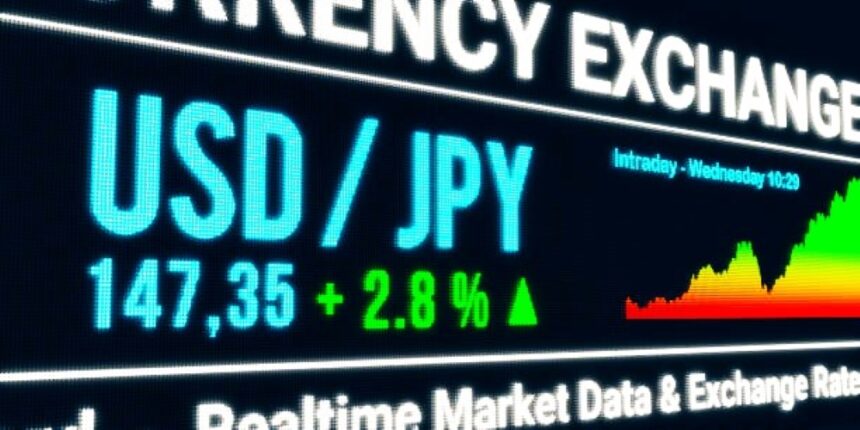Japanese yen Lower as Safe-Haven Status and BoJ-Fed Policy Divergence Drive USDJPY.
The Japanese Yen (JPY) has extended its bullish momentum into the new trading week, with the USDJPY pair hovering near multi-month lows last seen in September 2024. Amid an intensifying global geopolitical backdrop and diverging central bank policy paths, the JPY remains firmly on the front foot. The surge in safe-haven demand and growing speculation over policy shifts on both sides of the Pacific continue to drive the Yen’s strength.
US-China Trade War Escalation Sparks Fresh Safe-Haven Rush
The ongoing US-China trade war is once again front and center in global market narratives. Investor risk sentiment took a hit after both economic giants raised tariffs to levels unseen before. On Friday, China retaliated with a tariff hike on US goods to 125%, only hours after US President Donald Trump announced a 145% tariff on a broader range of Chinese imports.
These tit-for-tat measures have reignited fears about a deepening trade rift, casting a long shadow over global economic growth. Investors, spooked by the potential ramifications for supply chains, corporate earnings, and international trade flows, have turned to traditional safe-haven assets. The Japanese Yen, often regarded as a fortress during uncertain times, is once again drawing substantial capital inflows.
Hopes for a US-Japan Trade Deal Add Tailwind to the Japanese Yen
While tensions with China escalate, Washington appears to be turning its attention to more constructive trade dialogues with Japan. Optimism about a US-Japan trade agreement is further strengthening the Japanese currency. Last week, President Trump acknowledged that “tough but fair” parameters were being established for bilateral negotiations.
US Treasury Secretary Scott Bessent reinforced this sentiment, signaling that Japan could be prioritized in upcoming tariff negotiations. Such remarks have boosted investor expectations for a potential breakthrough deal, which could benefit both the Japanese economy and the Yen.
Further support came from Tokyo’s top economic policymakers. Japanese Prime Minister Shigeru Ishiba sounded the alarm on the broader implications of US tariff policy, warning that it could “disrupt the world economic order.” Finance Minister Shunichi Kato and Economy Minister Ryosei Akazawa echoed concerns over currency volatility, underscoring their commitment to stabilizing the Yen and cooperating with US authorities on foreign exchange issues.
BoJ Stance Turns Hawkish as Inflation Pressures Build
A key pillar behind the Yen’s current rally is the growing belief that the Bank of Japan (BoJ) will stay on a hawkish course throughout 2025. On Thursday, the BoJ released preliminary data showing wholesale inflation accelerated to 4.2% in March — a clear sign that price pressures are broadening across the Japanese economy.
This inflation uptick, coupled with evidence of strong wage growth in early Q2, gives the BoJ sufficient justification to maintain or even intensify its tightening cycle. For a central bank that had long been the poster child of ultra-loose monetary policy, this marks a historic shift.
Rising domestic inflation and resilient labor market conditions mean the BoJ may hike rates again, perhaps multiple times this year. Markets have taken note, and JPY bulls are pricing in further appreciation, especially as policy divergence with the US becomes more pronounced.
Fed Pivot Reinforces USD Weakness
In stark contrast to Japan’s hawkish tilt, the Federal Reserve appears poised to move in the opposite direction. The latest Consumer Price Index (CPI) data showed that US inflation cooled significantly in March, with core inflation easing across several categories.
This dovish inflation print has added to a string of recent data — including declining consumer sentiment and weaker labor market indicators — suggesting the US economy may be slowing down. As a result, market expectations for Fed rate cuts have surged.
According to the latest futures pricing, traders are now anticipating up to 90 basis points in rate reductions by the end of 2025. This aggressive repricing has weighed heavily on the US Dollar, which slipped to its weakest level since April 2022 last Friday. The USD/JPY pair followed suit, retreating sharply and testing key support levels during Monday’s Asian session.
BoJ-Fed Policy Divergence: The Key Driving Force
The diverging paths of the BoJ and the Fed are creating a powerful macroeconomic force behind the Yen’s advance. Higher interest rates in Japan combined with declining US yields are narrowing the yield differential — a fundamental driver of currency exchange rates.
Historically, the USD/JPY pair has been highly sensitive to these policy differentials. When US rates rise faster than Japan’s, the Dollar strengthens. But in the current environment, the opposite dynamic is in play.
With the Fed expected to cut rates and the BoJ looking increasingly likely to raise them, investors are shifting their capital accordingly. The lower-yielding Yen is now relatively more attractive, especially in a risk-off environment where capital preservation trumps yield-seeking behavior.
Improving Global Sentiment May Cap Further Yen Gains
Despite the Yen’s recent strength, some analysts caution that further gains could be limited if global risk sentiment begins to recover. Signs of progress in US-China talks or a rebound in equities could reduce the urgency of safe-haven positioning.
Moreover, Japanese authorities remain wary of excessive Yen appreciation, which could hurt exports and corporate profits. Any sharp rally could invite verbal intervention from policymakers or even coordinated action with other central banks to temper the JPY’s ascent.
Still, as long as geopolitical tensions simmer and monetary policy divergence persists, the bias for the USDJPY pair remains tilted to the downside.
[faq-schema id=”39374″]









